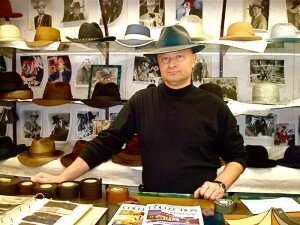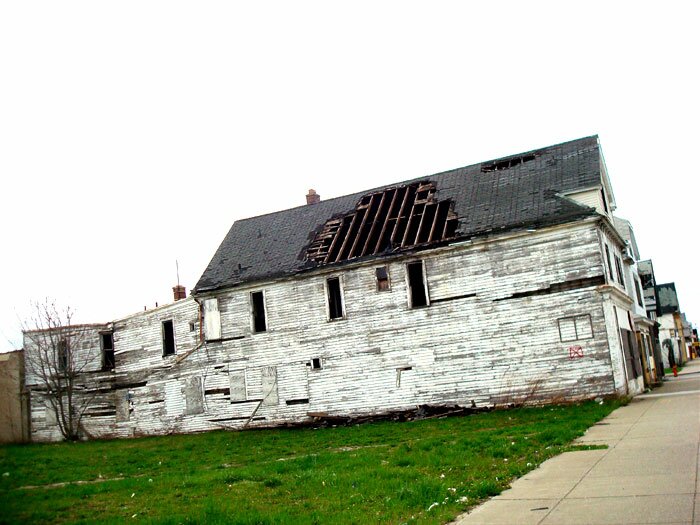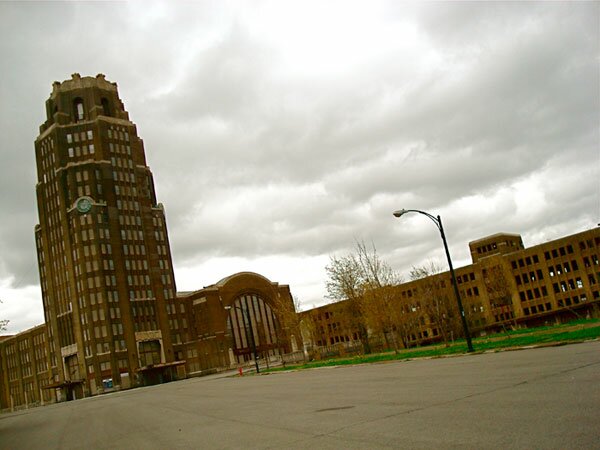BUFFALO, N.Y. — The hatmaker who has dressed James Garner and Leonardo DiCaprio runs a shop on Broadway Street, steps from the Family Dollar store. Few other businesses are open on this East Side drag, a commercial district that hummed with foot traffic in decades past.
Several doors down, vintage, red-and-yellow lettering announces the Club Romway tavern, but the establishment closed years ago and the three-floor building that housed it is boarded up. Plastic bottles and fast food wrappers slick with grease and cheese litter sidewalks. Vandals, time and weather have reduced homes in the area to rotting shells, their empty innards exposed to wind, rain and snow that rush in through gaping holes where glass used to be.
Gary Witkowski has worked here for more than 20 years, crafting and altering fedoras, pork pies, gamblers, homburgs, coachmen and three-point diamonds for clients including Hollywood costume designers and author and newspaperman Gay Talese. The late Alfred Lerner, former owner of the Cleveland Browns, bought 51 hats, Witkowski says.
Today, Witkowski’s handiwork sells for upwards of $500 apiece. Customers call in orders from around the country. They have heard of the hat man in Buffalo who uses antique grosgrain ribbon, century-old tools, and the finest beaver, chinchilla and muskrat furs. Witkowski could leave East Buffalo if he wanted, and he is pondering moving his boutique, the Custom Hatter, to a more well-trafficked spot in the city or to the wealthy suburb of Williamsville. But for years, he has stayed put, growing his business while watching the neighborhood decline.
“I think he feels comfortable there…It’s kind of an unspoken thing. He knows it. He’s familiar,” says his daughter, Jenna, a 25-year-old social worker.
“That store,” she says, “is within a few blocks radius from the area he’s been his whole life.”
Witkowski, 55, grew up on Lombard Street, about a mile from where he works today. His family, Polish and Roman Catholic, was typical of the East Side at the time. His father was a truck driver, his mother a homemaker who raised Witkowski and a younger brother.
From morning through evening during Witkowski’s youth, the community was alive. Paperboys perched on corners, selling the News and the now-defunct Courier-Express to factory workers and passengers catching trains at the local station, the city’s largest. Patrons browsed the racks at Sattler’s department store at 998 Broadway, just east of Fillmore Avenue and a short walk from where the Custom Hatter sits. Diners enjoyed Friday fish fries at the Broadway Grill, which, like Sattler’s, has closed.
“You could walk from Fillmore Avenue to Bailey Avenue, and there were thousands of people on the street. There were five, 600 people at a pop walking the area here,” Witkowski recalls, gazing, with vivid blue eyes, out onto an empty street.
The old neighborhood, Buffalo’s historic Polonia, now exists only in memory. In summer, Witkowski will sometimes stand out on the sidewalk, sanding hats and chatting with visitors who stop to watch. He remains friendly with fellow business owners. He still loves the people. Sometimes, children who live nearby drop in to help him clean. But the Broadway-Fillmore area is a ghost of what it once was, and Witkowski knows that.
“It’s a neighborhood that I grew up in,” he says, in a quiet but firm voice. “But it’s no longer my neighborhood.”
After graduating from Seneca Vocational High School in 1972, Witkowski wound up as a stocker, salesman and buyer in the hat department of Peller & Mure, an upscale men’s clothing shop downtown. There, he acquired a taste for quality, coming to see a good fedora or trilby as the flourish that finished a fine suit. He dreamed of owning his own store and set out to learn the hatter’s trade, commuting, by car, to Lynn, Mass. on weekends and holidays to apprentice under an artisan named Henry Goldstein.
Finally, in the 1980s, Witkowski was ready: He opened shop on Broadway, sewing, pressing and steaming deep into the night after completing shifts at Peller & Mure. He quit his day job a few years later to turn his full attention to the Custom Hatter, where he specialized in men’s wear and went by the pseudonym “Gary White” because he was told his Polish surname would not sit well with high-end clients.
By then, Witkowski says, the East Side’s “transition” was well under way. Changes in Broadway-Fillmore had begun in the 1950s and accelerated the decade after, with working-class homeowners embarking on a migration to the suburbs. The exodus left a vast stock of cheap housing in the community at a time when urban renewal projects were pushing Buffalo’s growing African American population out of parts of the city where blacks had traditionally lived.
Thousands of these displaced people, many poor, relocated to Broadway-Fillmore, says Henry Louis Taylor Jr., director of the University at Buffalo’s Center for Urban Studies. Some were originally economic migrants — workers from states like Mississippi and Tennessee who had moved north seeking industrial jobs as the mechanical cotton picker reduced the need for farmhands in the South.
Poverty settled in, with factory closures worsening conditions. The local railroad terminal, built in the 1920s to accommodate 200 trains a day, shut down. And late one evening in the early 1990s, Witkowski awoke to find police arresting “a guy with an Uzi” on the front porch of Witkowski’s Lombard Street home.
For Jenna’s sake, Witkowski says, he moved to West Seneca. But he never really left East Buffalo. From the Custom Hatter at 1318 Broadway, a property he bought, he continued honing his craft. And as the neighborhood went to hell, his shop became a gem.
The New York Times and Fortune Magazine featured his boutique. He made hats, he says, for stage productions including “Guys and Dolls” and “Wonderful Town,” and films including “The Untouchables,” “Dick Tracy,” and “Revolutionary Road.” (I could not independently verify all of Witkowski’s show and movie credits, but Broadway costume designer Martin Pakledinaz confirms Witkowski’s qualifications, saying Witkowski made dozens headpieces for “Thoroughly Modern Millie,” a 2002 musical for which Pakledinaz won the Tony Award for Best Costume Design.)
Today, Witkowski’s workshop is an explosion of color, with rolls of ribbon in oranges, azures, pinks and greens stacked in and overflowing from plastic tubs. In the front room where he meets customers, hat bodies — the raw, limp, unshaped felts he molds into headwear — sit in piles sorted by hue: chocolate, copper, nutmeg, burgundy, moss green, bone and navy blue.
Witkowski is old-fashioned. He sews satin linings and sheepskin leather sweatbands into hats instead of using glue. He maintains a Web site, but to order, clients must call, pay a visit, or mail in requests.
“To me, something like Gary’s store represents hope…It’s an artist and craft, and in a way, it sort of represents what the other businesses were back when the neighborhood was thriving,” says Christopher Byrd, co-founder of Broadway-Fillmore Alive, a group devoted to revitalizing the area and preserving its history. “That’s what you had — you had a lot of people running their own stores. There weren’t many chains.”
Witkowski talks fondly, too, of the old East Side. He remembers how when he started his business —when “I couldn’t give my hats away” — his only supporters were African American men in the area who were willing to pay to look their best at church and social events.
Today, glimmers of life give the community hope. Shoppers still descend each spring on the nearby Broadway Market to buy breads, meats, painted eggs, pierogi and boxes of twisted, sugar-coated chrusciki for Easter celebrations.
But in Broadway-Fillmore, lasting change can seem out of reach. Year after year, Witkowski has watched his neighborhood slip as politicians talk about developing the city’s waterfront and hand subsidies to corporations willing to locate in Western New York. He is among many entrepreneurs who believe Buffalo distributes small business grants unfairly. Rebuilding Broadway-Fillmore rises as a flashpoint in elections, but the reality is that the region’s leaders abandoned the area long ago, Witkowski says: “Too many promises, and not enough promises delivered.”
In his mind, Witkowski can still see the old Broadway, packed with the crowds that gave the neighborhood life. But, he says, “it means nothing anymore.” He looks outside, and the sidewalks are quiet. He need only walk next door to find a storefront with newspapers and wooden boards covering almost every window.
On the drive to work, Witkowski passes houses in such a state of decay that they look as if they have been turned inside-out, their wooden skeletons sketched, stark and ragged, on a gray Buffalo sky. The local vacancy rate is so high that the city has taken to demolishing unwanted homes, leaving behind a trash-ridden patchwork of urban prairie.
Half a mile from the Custom Hatter, the 17-story Central Terminal looms, a hulking, boarded-up brick ghost. The last train left the station, an art deco wonder, in October of 1979. Witkowski calls himself a holdout. But even he no longer believes the community will turn back around in his lifetime. After 55 years here, it could be time to move on.
Charlotte, the author of this story, works in the University at Buffalo’s communications office. This blog is independent of her job at UB, and she had not met Henry Louis Taylor Jr. prior to reporting for this article.









You have found a hidden gem I would never have known about! So glad you came to my city and are revealing it to me! So well-written: decayed houses that “look as if they have been turned inside-out, their wooden skeletons sketched, stark and ragged, on a gray Buffalo sky.”
Great article about the struggle of business in a decaying community and how quality still matters to some.
great story!
Pingback: Broadway Fillmore Alive » Making Hats for Hollywood on Buffalo’s East Side
Excellent article, Charlotte!! Thank you for writing it
You had me at chinchilla. Great story, Charlotte!
Great story. Puts a face on an urban reality that many of us don’t see from our cars whizzing past on the freeway.
Thanks for all the kind words =). Aunt Patty & Joe… I learned a lot from writing this story, too. Reporting is wonderful because it takes me to parts of the city I don’t usually visit. It was so interesting to me that Mr. Witkowski had chosen to stay on Broadway all these years. I had to find out why —
Hi Charlotte:
I enjoyed your article very much. It always pains me to see how much the city has fallen and your articles are a ray of hope in an otherwise bleak landscape. Keep it up!
Great piece- again! Always love how you weave in the history of the city, take me to a place I’ve never been, as well as introduce me to people I’d never otherwise know. Thank you!
Im going to visit. What an awesome story.
Great work and thank you
To the contrary, thank you for reading…
A 100% accurate portrayal of the decline of the once vibrant Broadway-Fillmore district. Great article! Thanks for telling like it is. Most younger people can’t even imagine how wonderful this area once was. You are a great writer!!
This is a wonderful story! I had no idea that we had such a gem.